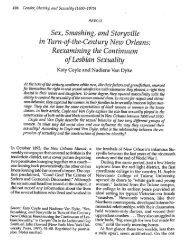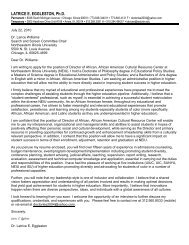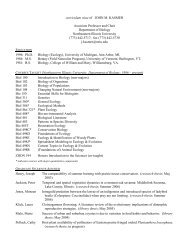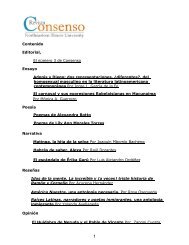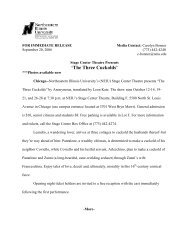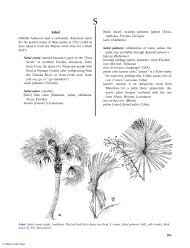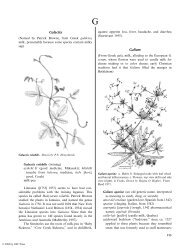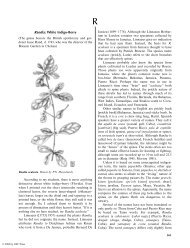Herba Cana - Northeastern Illinois University
Herba Cana - Northeastern Illinois University
Herba Cana - Northeastern Illinois University
You also want an ePaper? Increase the reach of your titles
YUMPU automatically turns print PDFs into web optimized ePapers that Google loves.
© 2004 by CRC Press<br />
The Ethnobotany 523<br />
westerse plataan (western plane-tree, Dutch,<br />
<strong>Cana</strong>da, USA, West Indies)<br />
aya (Veracruz)<br />
ayan’ sanhan’ udi’ (‘‘strong wood tree’’ or san,<br />
white?, Biloxi; compare with Omaha jan san,<br />
white wood and Osage sansan, white sycamore)<br />
bois puant (stinking tree, <strong>Cana</strong>da, France)<br />
butterwood (a corruption of ‘‘button’’?, North<br />
America); buttonball[-tree] (USA); buttonwood<br />
(surely an allusion to the round, buttonlike<br />
fruits; recorded in Swedish by Kalm in 1753;<br />
first published in English by Frederick Pursh in<br />
1814 for this species, <strong>Cana</strong>da, United Kingdom)<br />
ciɬ ó (Koasati); sini (Choctaw)<br />
cotonier (cotton tree, French, USA)<br />
keisewaquata (Shawnee, fide Edgar 1891)<br />
kuwajunega (Cherokee)<br />
oo-da-te-cha-wunnes (big stockings, Delaware?,<br />
USA)<br />
[American] sycamore tree [sycomore] (‘‘sycamore’’<br />
was originally applied to Ficus sycamorus, a fig in<br />
Egypt, Syria, and nearby countries. The word is<br />
a combination of Greek sykos, fig, and moros,<br />
the mulberry, and came into English about A.D.<br />
1300. By ca. 1588, it was applied to European<br />
Acer pseudoplatanus, and then to American<br />
Platanus by 1814 or perhaps before.)<br />
Virginia maple (name in New England in the<br />
1740s, fide Kalm 1753)<br />
wasbok [watenbok] (water beech, used by Swedes<br />
in Pennsylvania in the 1740s, Kalm 1753); water<br />
beech [waterbeech] (published in Swedish by<br />
Peter Kalm in 1753; the OED says first in<br />
English by Frederick Pursh in 1814)<br />
yap hi·tuwi·’ (tree of burrs); yap taktce’ hi·tcuwi·’hare<br />
[ya bwe] (tree white [of] many burrs,<br />
Catawba)<br />
The common names ‘‘plane-tree’’ and ‘‘sycamore’’<br />
have been confused in English since the 1300s. That<br />
confusion reflects the application of the names to Acer<br />
pseudoplatanus and Platanus orientalis. For example,<br />
Vickery (1993) devotes almost two pages to the<br />
‘‘sycamore’’ (Acer), yet that maple in Norway is the<br />
tanbark plane (platanlønn). In the United States, a<br />
‘‘sycamore’’ is Platanus.<br />
The name ‘‘plane’’ was in English before the<br />
‘‘official’’ introduction of Platanus. In 1398, a John<br />
De Trevisa wrote, ‘‘The plane is a colde tre and a drye,<br />
and ye leaves therof helep in hoot eveles.’’ Therefore,<br />
by that period, Europeans as far north as England<br />
were making medical use of a ‘‘plane’’ tree that must<br />
have been Acer.<br />
William Turner’s <strong>Herba</strong>ll recorded that P. orientalis,<br />
a native to Asia Minor, was introduced into Britain<br />
around 1562 (OED 1971). Then, 78 years later, John<br />
Parkinson told us that John Tradescant had P.<br />
occidentalis sent to him from Virginia and introduced<br />
it into England. Neither of these two species did<br />
well in the British Isles. In 1675, people noticed<br />
a different plane-tree. Although these hybrid trees<br />
(P. /acerifolia) are now called the ‘‘London Plane,’’<br />
they probably originated in France or Spain (Edlin<br />
and Mitchell 1985). From that point, the ‘‘plane’’<br />
became one of the most common street trees in<br />
England and much of the rest of Great Britain.<br />
The Cherokee were one of the few tribes recorded<br />
as using the wood of Platanus (Hamel and Chiltoskey<br />
1975). Settlers used the wood for crates, interior<br />
finishing, furniture, cooperage, rollers, butcher blocks,<br />
and tobacco boxes (Vines 1977). In spite of this usage,<br />
the technical sheet from the U.S. Forestry Service is<br />
not overly complimentary. It states that, although the<br />
wood is not durable, ‘‘It holds its shape well after<br />
steaming and machines, but requires high speed cutter<br />
heads to prevent chipping. It shrinks moderately in<br />
drying and is inclined to warp when flat sawn.’’ The<br />
sapwood is white to light yellow, while the heartwood<br />
is light to dark brown. Sycamore is classified as<br />
moderate in weight, hardness, stiffness, shock resistance,<br />
strength in bending, endwise compression, and<br />
nail-holding ability. It has a close texture, glues well,<br />
and resists splitting due to interlocked grain. The<br />
Forestry Service noted modern application in furniture<br />
(especially drawer sides), containers, millwork,<br />
flooring, veneer, pallets, boxes, plywood, pulp wood,<br />
paper, and particle boards.<br />
Although there seem to be no medical applications<br />
of Platanus in Europe, indigenous Americans used it<br />
throughout its range. The Cherokee considered the<br />
trees, but especially the bark, cathartic and emetic, and<br />
used it for menstrual and urinary problems and<br />
measles. They also treated dysentery with an inner<br />
bark infusion. Externally, the Cherokee and Iroquois<br />
used sycamore in a steam bath for rheumatism (Hamel<br />
and Chiltoskey 1975, Moerman 1998). The Creeks,<br />
Delaware, and Meskwaki treated colds, sore throat,<br />
hoarseness, and tuberculosis with the bark. The<br />
Cherokee, Iroquois, and Meskwaki used bark or root<br />
infusions to treat skin eruptions, scabs, eczema, and<br />
knife and ax wounds (Swanton 1928a, Taylor 1940,<br />
Hamel and Chiltoskey 1975, Moerman 1998).<br />
Moerman (1998) recorded Mahuna use of this<br />
species, but this tree does not grow there (Hickman<br />
1993).<br />
Foster and Duke (1990) found that the bark was<br />
once recommended by descendants of Europeans for<br />
rheumatism and scurvy. They found no evidence of<br />
efficacy. Lewis and Elvin-Lewis (1977) mention only<br />
that the airborne pollen causes allergies. Hocking





